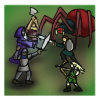
Conflicts in Rising Empires are common. Even the most peaceful empires with no wish to expand aggressively will most likely than not come into conflict with a neighboring empire. When there is no more room to expand peacefully some empires will look desperately at your own territory, while others might choose to turn inwards and improve what they already have. Whatever your playing style is, you will need to learn the basics of the combat system.
This is the seventh Rising Empires 2 tutorial and due to its length and complexity it has been split in three parts. This part is a general introduction to combat in Rising Empires. The next two parts will give you a detailed look of the ground combat system, discuss special rules and discuss how armies retreat and what happens when a settlement is captured:
Part III – Conquering settlements and special rules
Here comes a list of all the other Rising Empires tutorials that have been written:
Tutorial I – Playing the first turn in Rising Empires
Tutorial II – Research and technologies
Tutorial III – Loyalty, or how to keep your population happy
Tutorial IV – Corruption, or how to keep your empire together
Tutorial V – Food, or how you keep your population from starving
Tutorial VI – Troop statistics, or how to design the ‘super soldier’
The cost of war
War is fun! Every Human King, Greenskin Warlord or Dwarven Clan Leader should run around and wreak havoc among their enemies. Pillage their cities and torch their granaries. A war can bring great benefits to the winner; new cities and more population means more income, larger armies and a faster development of your great empire. Aren’t there any drawbacks?
Of course there are… Recruiting your civilians into military companies decreases your tax income and increases your expenditure in wages. But the worst part is when your soldiers start to die on the battlefield. Few things in your empire are as limited as your population… A conflict is good as long as you win and capture your enemy’s population, but when your soldiers die faster than your population increases you are in a dangerous situation.

And what can you do with all those Krant insectoids you just got in your empire?
Choosing sides in a battle
In a battle there can only be two sides, the attacker and the defender. The empire/faction that moves to a sector and engage an enemy is always the attacker. The defender is the faction that is being locked in combat when an enemy is moving into the sector.
Important note regarding civilian armies – Civilian armies (armies consisting only of companies without offensive combat values) cannot enter sectors with hostile armies, i.e. they can never initiate a ground combat.
All combat initiated during a movement phase is executed at the end of the movement phase, i.e. when all armies/fleets that can move have moved.
If a battle is initiated the defending faction is locked and may not leave the sector. Their movement will continue the next movement phase (or turn if there are no more movement phases that turn). More armies/fleets from both factions can still enter the sector and join the battle during the rest of the movement phase before the battle is executed. A good tactics is to use low-initiative armies to lock your enemy and force them to stay in a sector and then enter with your larger and slower army consisting of your real combat veterans.
Armies/fleets that enter a sector where a battle already has been initiated will join the side of its own empire first. If no armies of its own empire are present in the battle it will join the side of its allied empires. If the army does not belong to either side of the already started battle a new battle will be initiated. The army will then meet the winner of the first battle.

